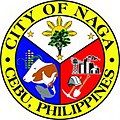Naga | |
|---|---|
| City of Naga | |
 Highway in Naga | |
| Nickname: The Industrial Hub of Southern Cebu [1] | |
| Mottoes: Naga atong garbo Service with a Heart The Naga of Visayas | |
| Anthem: Mahal Kong Naga (My Beloved Naga) | |
 Map of Cebu with Naga highlighted | |
Location within the Philippines | |
| Coordinates: 10°13′N123°45′E / 10.22°N 123.75°E | |
| Country | Philippines |
| Region | Central Visayas |
| Province | Cebu |
| District | 1st district |
| Founded | 1785 |
| Cityhood | September 2, 2007 (Lost cityhood in 2008 and 2010) |
| Lost cityhood | 2008 and 2010 |
| Affirmed cityhood | February 15, 2011 |
| Barangays | 28 (see Barangays) |
| Government | |
| • Type | Sangguniang Panlungsod |
| • Mayor | Valdemar M. Chiong (NP) |
| • Vice Mayor | Virgilio M. Chiong (NP) |
| • Representative | Rhea Mae A. Gullas (Lakas) |
| • City Council | Members |
| • Electorate | 86,935 voters (2025) |
| Area | |
• Total | 101.97 km2 (39.37 sq mi) |
| Elevation | 105 m (344 ft) |
| Highest elevation | 819 m (2,687 ft) |
| Lowest elevation | 0 m (0 ft) |
| Population (2024 census) [4] | |
• Total | 138,727 |
| • Density | 1,360.5/km2 (3,523.6/sq mi) |
| • Households | 32,011 |
| Economy | |
| • Income class | 3rd city income class |
| • Poverty incidence | 26.02 |
| • Revenue | ₱ 1,385 million (2022) |
| • Assets | ₱ 4,622 million (2022) |
| • Expenditure | ₱ 1,016 million (2022) |
| • Liabilities | ₱ 1,456 million (2022) |
| Service provider | |
| • Electricity | Visayan Electric Company (VECO) |
| Time zone | UTC+8 (PST) |
| ZIP code | 6037 |
| PSGC | |
| IDD : area code | +63 (0)32 |
| Native languages | Cebuano Tagalog |
| Website | www |
Naga, officially the City of Naga (Cebuano : Dakbayan sa Naga; Filipino : Lungsod ng Naga), is a component city in the province of Cebu, Philippines. According to the 2024 census, it has a population of 138,727 people. [6]
Contents
- History
- Colonial Era
- Post-war Era
- Cityhood
- Geography
- Barangays
- Climate
- Demographics
- Economy
- Sports venues
- References
- Sources
- External links
Naga City is bordered to the north by the town of Minglanilla, to the west is the city of Toledo, to the east is the Cebu Strait, and to the south is the town of San Fernando. It is 21 kilometres (13 mi) from Cebu City.
It lies within the Cebu metropolitan area. [7]
It is one of the two Philippine cities named Naga, the other being Naga, Camarines Sur in Luzon.






